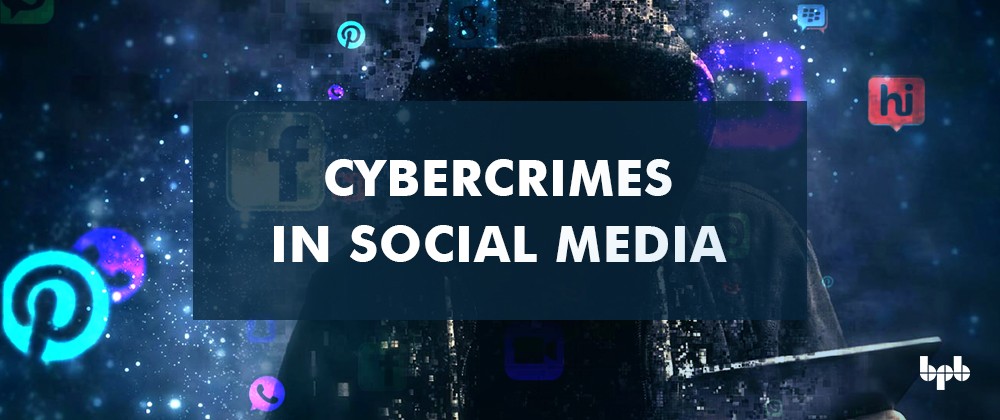Almost everyone, from children, teenagers, housewives, working professionals to unskilled manpower, spends time on social media for various reasons. Cybercrimes such as cyberbullying, MMS, threatening messages, fake profiles, identity theft, cyber harassment, cyberstalking, and so on are very common on social media. Cybercriminals not only target individuals but they conduct automated attacks using bots.
Following are some of the common cybercrimes in social media:
- Impersonation/identity theft:?Cybercriminals obtain someone else personal information to commit frauds such as fake profile creation on social media, internet banking frauds, e-commerce transactions, and so on. They may trick the victim using various techniques such as phishing, phone scams, or skimming (illegal methods to obtain credit/debit card information using skimmer) installed at ATMs point-of-sale).
- Cyberbullying:?It is an act of sharing false, racial, fake, or harmful content such as text, photographs, videos, and so on, which can cause embarrassment or humiliation to someone. Easy targets are school kids, teenagers, women, and co-working professionals.
- Cyber teasing:?It is a behavioral pattern of an individual. These personalities specially target women and humiliate them on social media such as Facebook, Twitter, Instagram, and WhatsApp. They post indecent comments or certain viral videos.
- Cyber?defamation: It is an act when false information is published to malign the reputation of an individual or group, or false campaigns are being run by someone to tarnish the image of any organization.
- Cyberstalking: It is a well-planned cybercrime. Initially, one may send negative or unpleasant comments or messages, but later on, cybercriminals send annoying messages or post false accusations on commonly used social media apps or portals. These messages may be from one or many accounts managed by the same person. Sometimes cyberstalking is done indirectly to collect personal information with the intention of identity theft. It has been found that normally cyberstalkers are known to the victim or his/her family.
- Cyber pornography:?Pornographers sell porn content to people over social media; they may create fake profiles to do so. Watching and keeping porn content is illegal in India. Please see the reference website as follows: https://legalserviceindia.com/. Cyber obscenity is a criminal offense in India, and it imposes liability on an offender under sections 66E and 67. To include children in sexual acts or online relationships is also illegal.
- Revenge pornography:?Publication/distribution of sexual content to disgrace or tarnish the image of an individual. These videos may be made with or without the consent of the subject but are distributed without consent. Children, teenagers, and women are the main targets, but any colleague can also do this irrespective of gender in any organization due to jealousy.
- Doxing: It is a short form of dropping dox. It is a practice of collecting and publishing someone’s personal information over the internet. Cybercriminals do it for online harassment or extortion or to threaten someone. Sometimes doing is done by the investigators for legal investigation or by corporate houses for business analysis.
- Cyber?swatting: An online harassment technique used on the internet often by the online gaming community. It includes making a hoax call at police or fire or ambulance helpline, providing false information to the authorities to create panic, or sending any emergency support at someone’s location. Cyber criminals’ motives can be cyber harassment, revenge, or financial gains.
- Cyber trolling:?Initiation of discords or hurting the people’s sentiments by saying something controversial to provoke others. YouTube, Twitter, and WhatsApp are the common platforms for cyber trolling. It may target an individual to a specific group, community, or celebrities.
- Catfishing: It is a deception technique; cybercriminals create a fake online identity to commit financial fraud, but they may do it for the sake of revenge or to trap or abuse children or women.
- Hacking?and?frauds: By creating fake accounts or tricking people, cybercriminals get personal/sensitive information such as login credentials, banking details, or take over someone’s social media account.
- Vacation robberies:?Criminals do recce on social media to know the whereabouts of their target. People publish their vacation and even live locations on social media, and criminals take advantage of it to commit a crime.
- Fake?online?friendship: Cybercriminals especially trick children, teenagers, and women using emotional connect. Sometimes they even send gifts to trap their target and later use them for various criminal activities such as money laundering. They even trick them into getting money on the pretext of medical emergencies or problems in a foreign country.
- Buying?illegal?items: By creating fake profiles, cybercriminals use social media to trade illegal or banned items.
Our objective is to make you aware of various social media-related cybercrime and preventive steps to safeguard.
